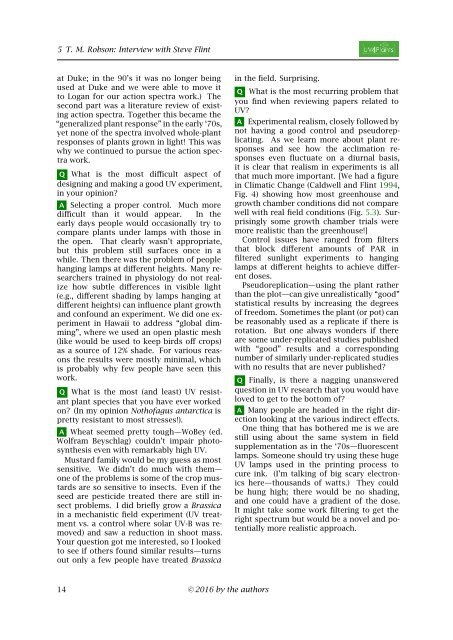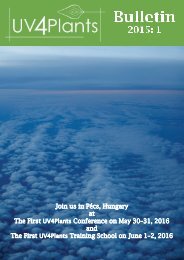UV4Plants Bulletin 2016:1
The Bulletin of the <a href="http://www.uv4plants.org>UV4Plants Association</a> is published two times per year. It is an open-access publication.
The Bulletin of the <a href="http://www.uv4plants.org>UV4Plants Association</a> is published two times per year. It is an open-access publication.
Create successful ePaper yourself
Turn your PDF publications into a flip-book with our unique Google optimized e-Paper software.
5 T. M. Robson: Interview with Steve Flint<br />
at Duke; in the 90’s it was no longer being<br />
used at Duke and we were able to move it<br />
to Logan for our action spectra work.) The<br />
second part was a literature review of existing<br />
action spectra. Together this became the<br />
“generalized plant response” in the early ‘70s,<br />
yet none of the spectra involved whole-plant<br />
responses of plants grown in light! This was<br />
why we continued to pursue the action spectra<br />
work.<br />
Q What is the most difficult aspect of<br />
designing and making a good UV experiment,<br />
in your opinion?<br />
A Selecting a proper control. Much more<br />
difficult than it would appear. In the<br />
early days people would occasionally try to<br />
compare plants under lamps with those in<br />
the open. That clearly wasn’t appropriate,<br />
but this problem still surfaces once in a<br />
while. Then there was the problem of people<br />
hanging lamps at different heights. Many researchers<br />
trained in physiology do not realize<br />
how subtle differences in visible light<br />
(e.g., different shading by lamps hanging at<br />
different heights) can influence plant growth<br />
and confound an experiment. We did one experiment<br />
in Hawaii to address “global dimming”,<br />
where we used an open plastic mesh<br />
(like would be used to keep birds off crops)<br />
as a source of 12% shade. For various reasons<br />
the results were mostly minimal, which<br />
is probably why few people have seen this<br />
work.<br />
Q What is the most (and least) UV resistant<br />
plant species that you have ever worked<br />
on? (In my opinion Nothofagus antarctica is<br />
pretty resistant to most stresses!).<br />
A Wheat seemed pretty tough—WoBey (ed.<br />
Wolfram Beyschlag) couldn’t impair photosynthesis<br />
even with remarkably high UV.<br />
Mustard family would be my guess as most<br />
sensitive. We didn’t do much with them—<br />
one of the problems is some of the crop mustards<br />
are so sensitive to insects. Even if the<br />
seed are pesticide treated there are still insect<br />
problems. I did briefly grow a Brassica<br />
in a mechanistic field experiment (UV treatment<br />
vs. a control where solar UV-B was removed)<br />
and saw a reduction in shoot mass.<br />
Your question got me interested, so I looked<br />
to see if others found similar results—turns<br />
out only a few people have treated Brassica<br />
in the field. Surprising.<br />
Q What is the most recurring problem that<br />
you find when reviewing papers related to<br />
UV?<br />
A Experimental realism, closely followed by<br />
not having a good control and pseudoreplicating.<br />
As we learn more about plant responses<br />
and see how the acclimation responses<br />
even fluctuate on a diurnal basis,<br />
it is clear that realism in experiments is all<br />
that much more important. [We had a figure<br />
in Climatic Change (Caldwell and Flint 1994,<br />
Fig. 4) showing how most greenhouse and<br />
growth chamber conditions did not compare<br />
well with real field conditions (Fig. 5.3). Surprisingly<br />
some growth chamber trials were<br />
more realistic than the greenhouse!]<br />
Control issues have ranged from filters<br />
that block different amounts of PAR in<br />
filtered sunlight experiments to hanging<br />
lamps at different heights to achieve different<br />
doses.<br />
Pseudoreplication—using the plant rather<br />
than the plot—can give unrealistically “good”<br />
statistical results by increasing the degrees<br />
of freedom. Sometimes the plant (or pot) can<br />
be reasonably used as a replicate if there is<br />
rotation. But one always wonders if there<br />
are some under-replicated studies published<br />
with “good” results and a corresponding<br />
number of similarly under-replicated studies<br />
with no results that are never published?<br />
Q Finally, is there a nagging unanswered<br />
question in UV research that you would have<br />
loved to get to the bottom of?<br />
A Many people are headed in the right direction<br />
looking at the various indirect effects.<br />
One thing that has bothered me is we are<br />
still using about the same system in field<br />
supplementation as in the ‘70s—fluorescent<br />
lamps. Someone should try using these huge<br />
UV lamps used in the printing process to<br />
cure ink. (I’m talking of big scary electronics<br />
here—thousands of watts.) They could<br />
be hung high; there would be no shading,<br />
and one could have a gradient of the dose.<br />
It might take some work filtering to get the<br />
right spectrum but would be a novel and potentially<br />
more realistic approach.<br />
14 © <strong>2016</strong> by the authors



